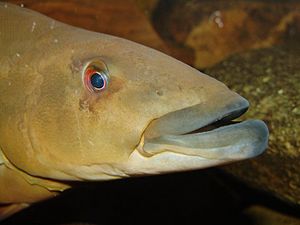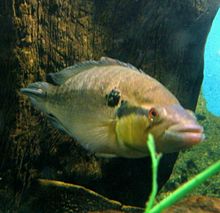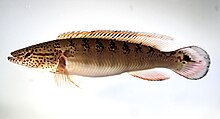Pike cichlids
| Pike cichlids | ||||||||||||
|---|---|---|---|---|---|---|---|---|---|---|---|---|

Xingu common perch , Crenicichla Xingu 1 |
||||||||||||
| Systematics | ||||||||||||
|
||||||||||||
| Scientific name | ||||||||||||
| Crenicichla | ||||||||||||
| Heckel , 1840 |
The pike or comb cichlid ( Crenicichla , synonym : Batrachops ) are a genus of cichlids from tropical and subtropical South America . The scientific generic name refers to the sawn gill cover ( Greek : "krene" = comb + cichla , a genus of cichlids).
features
Pike cichlids grow to a length of 8 to over 30 centimeters (a species or variant of C. lugubris that is widespread in the Venezuelan Orinoco catchment up to 50 cm). Their body is elongated like a pike, the number of vertebrae is high (at least 32). There are more trunk than tail vertebrae, while most other cichlids do the opposite. The dorsal fin is relatively long, with 16 to 24 fin spines and 11 to 19 soft rays. The anal fin is short and is symmetrically opposite the soft-rayed part of the dorsal fin. Both fins are pointed in the males. The lower jaw usually protrudes.
Way of life
Pike cichlids are predatory fish, which with their deeply split mouth can also overwhelm prey fish that are not much smaller than they are themselves. Fish are captured in a lightning-fast advance and devoured head first. Pike cichlids are cave breeders that attach their spawn to the side walls or ceiling of a cave. The female takes care of the spawn, while the male defends the territory . Once the young fish have hatched, both parents lead the school of young fish.
distribution
Pike cichlids live all over South America east of the Andes ; its southern limit of distribution is the Río Negro in northern Patagonia . They are also found on the Caribbean island of Trinidad , in the three guayanas , in the Amazon basin , in the Orinoco , Paraguay & Río Paraná and in most of the coastal rivers between the Amazon estuary and the Río de la Plata .
Internal system
There are more than 90 described species and about 20 undescribed. The genus Teleocichla , a group of cichlids that is strongly adapted to biotopes with high currents , is phylogenetically within Crenicichla . Crenicichla is divided into a number of species groups according to scale size, color, color change during the transition from the juvenile stage to the adult stage and other characteristics, which in the future may become independent genera. The genus is in great need of revision .
The cladogram shows the internal systematics of Crenicichla and the position of Teleocichla within Crenicichla :
| Crenicichla |
|
||||||||||||||||||||||||||||||
|
|
species
-
Crenicichla lacustris group
- Crenicichla celidochilus Casciotta, 1987
- Crenicichla empheres Lucena, 2007
- Crenicichla gaucho Lucena & Kullander, 1992
- Crenicichla gillmorlisi Kullander & Lucena, 2013
- Crenicichla hadrostigma Lucena, 2007
- Crenicichla haroldoi Luengo & Britski, 1974
- Crenicichla hu Pialek, Rican, Casciotta & Almiron, 2010
- Crenicichla igara Lucena & Kullander, 1992
- Crenicichla iguapina Kullander & Lucena, 2006
- Crenicichla iguassuensis Haseman, 1911
- Crenicichla jaguarensis Haseman, 1911
- Crenicichla jupiaensis Britski & Luengo, 1968
- Crenicichla jurubi Lucena & Kullander, 1992
- Crenicichla lacustris (Castelnau, 1855)
- Crenicichla lucenai Mattos et al., 2014
- Crenicichla maculata Kullander & Lucena, 2006
- Crenicichla mandelburgeri Kullander, 2009
- Crenicichla minuano Lucena & Kullander, 1992
- Crenicichla missioneira Lucena & Kullander, 1992
- Crenicichla mucuryna Ihering, 1914
- Crenicichla Niederleinii (Holmberg, 1891)
- Crenicichla prenda Lucena & Kullander, 1992
- Crenicichla punctata Hensel, 1870
- Crenicichla scottii (Eigenmann, 1907)
- Crenicichla taikyra Casciotta et al., 2013
- Crenicichla tapii Piálek et al., 2015
- Crenicichla tendybaguassu Lucena & Kullander, 1992
- Crenicichla tesay Casciotta & Almirón, 2009
- Crenicichla tingui Kullander & Lucena, 2006
- Crenicichla tuca Piálek et al., 2015
- Crenicichla vittata Heckel, 1840
- Crenicichla yaha Casciotta, Almirón & Gómez, 2006
- Crenicichla yjhui Piálek et al., 2019
- Crenicichla ypo Casciotta, Almirón, Piálek, Gómez & Říčan, 2010
-
Crenicichla reticulata group
- Crenicichla cametana Steindachner, 1911
- Crenicichla cyclostoma Ploeg, 1986
- Crenicichla cyanonotus Cope, 1870
- Crenicichla geayi Pellegrin, 1903
- Crenicichla jegui Ploeg, 1986
- Crenicichla macrophthalma Heckel, 1840 , type species
- Crenicichla reticulata (Heckel, 1840)
- Crenicichla sedentaria Kullander, 1986
- Crenicichla semifasciata (Heckel, 1840)
- Crenicichla stocki Ploeg, 1991
-
Crenicichla saxatilis group
- Crenicichla albopunctata Pellegrin, 1904
- Crenicichla alta Eigenmann, 1912
- Crenicichla anthurus Cope, 1872
- Crenicichla frenata Gill, 1858
- Crenicichla labrina (Spix & Agassiz, 1831)
- Crenicichla lepidota Heckel, 1840
- Crenicichla lucius Cope, 1870
- Crenicichla menezesi Ploeg, 1991
- Crenicichla pellegrini Ploeg, 1991
- Crenicichla ploegi Varella et al., 2018
- Crenicichla proteus Cope, 1872
- Crenicichla pydanielae Ploeg, 1991
- Crenicichla santosi Ploeg, 1991
- Crenicichla saxatilis (Linnaeus, 1758)
- Crenicichla sveni Ploeg, 1991
- Crenicichla vaillanti Pellegrin, 1903
-
Crenicichla lugubris group
- Crenicichla acutirostris Günther, 1862
- Crenicichla cincta Regan, 1905
- Crenicichla dandara Varella & Ito, 2018
- Crenicichla Johanna Heckel, 1840
- Crenicichla lenticulata Heckel, 1840
- Crenicichla lugubris Heckel, 1840
- Crenicichla marmorata Pellegrin, 1904
- Crenicichla monicae Kullander & Varella, 2015
- Crenicichla multispinosa Pellegrin, 1903
- Crenicichla percna Kullander, 1991
- Crenicichla phaiospilus Kullander, 1991
- Crenicichla rosemariae Kullander, 1997
- Crenicichla strigata Günther, 1862
- Crenicichla ternetzi Norman, 1926
- Crenicichla tigrina Ploeg, Jegu & Ferreira, 1991
- Crenicichla zebrina Montaña, López-Fernández & Taphorn, 2008
- Crenicichla Xingu I (named after the Rio Xingu )
- Crenicichla Xingu II
- Crenicichla Xingu III
-
Crenicichla wallacii group
- Crenicichla anamiri Ito & Rapp Py-Daniel, 2015
- Crenicichla compressiceps Ploeg, 1986
- Crenicichla heckeli Ploeg, 1989
- Crenicichla notophthalmus Regan, 1913
- Crenicichla regani Ploeg, 1989
- Crenicichla urosema Kullander, 1990
- Crenicichla virgatula Ploeg, 1991
- Crenicichla wallacii Regan, 1905 (named after Alfred Russel Wallace )
- not yet assigned to a species group
- Crenicichla adspersa Heckel, 1840
- Crenicichla brasiliensis (Bloch, 1792)
- Crenicichla britskii Kullander, 1982
- Crenicichla chicha Varella, Kullander & Lima, 2012
- Crenicichla coppenamensis Ploeg, 1987
- Crenicichla hemera Kullander, 1990
- Crenicichla hummelincki Ploeg, 1991
- Crenicichla inpa Ploeg, 1991
- Crenicichla isbrueckeri Ploeg, 1991
- Crenicichla nickeriensis Ploeg, 1987
- Crenicichla semicincta Steindachner, 1892
- Crenicichla sipaliwini Ploeg, 1987
literature
- Claus Schaefer: Crenicichla. In: Claus Schaefer, Torsten Schröer (Hrsg.): The large lexicon of aquaristics. Eugen Ulmer, Stuttgart 2004, ISBN 3-8001-7497-9 , pp. 281-285.
- Günther Sterba : The world's freshwater fish. 2nd Edition. Urania, Leipzig / Jena / Berlin 1990, ISBN 3-332-00109-4 .
- Günther Sterba (Ed.), Gert Brückner: Encyclopedia of Aquaristics and Special Ichthyology. Neumann-Neudamm, Melsungen u. a. 1978, ISBN 3-7888-0252-9 .
- Jens Gottwald: Pike cichlids of the genus Crenicichla. PDF .
Individual evidence
- ^ Claus Schaefer: Crenicichla. 2004, p. 285.
- ↑ ED Burress, F. Alda, A. Duarte, M. Loureiro, JW Armbruster, P. Chakrabarty: Phylogenomics of pike cichlids (Cichlidae: Crenicichla ): the rapid ecological speciation of an incipient species flock. Journal of Evolutionary Biology, 31 (1) October 2017, DOI: 10.1111 / jeb.13196
Web links
- Website of the Swedish cichlid specialist Sven O. Kullander: Crenicichla Heckel
- Pike cichlids on Fishbase.org (English)








